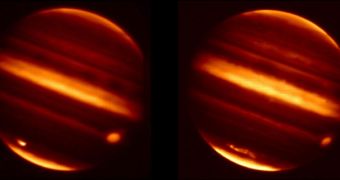An international team of investigators led by American researchers has recently determined that the space object which slammed into Jupiter's atmosphere on July 19, 2009 was in fact an asteroid, and not a comet, as previously stated.
The group was also able to determine that the space rock was approximately the size of the Titanic. Details of the work appear in the two papers, recently published in the esteemed journal Icarus.
This investigation was conducted using datasets collected in the infrared portion of the electromagnetic spectrum by three telescopes. These pieces of information allowed the scientists to peer at the unique chemical signatures created by the impact debris.
They were also able to observe the warm temperatures that the impactor left behind as it disintegrated in the Jovian atmosphere. Impact shock waves could also be analyzed in detail from these readings.
Experts found that all the data indicate an asteroid as the impactor, rather than a comet, as previously believed. There were no signs that an icy body was responsible for the atmospheric distortions the telescopes observed.
“Both the fact that the impact itself happened at all and the implication that it may well have been an asteroid rather than a comet shows us that the outer solar system is a complex, violent and dynamic place, and that many surprises may be out there waiting for us,” says Glenn Orton.
“There is still a lot to sort out in the outer solar system,” adds the expert, who holds an appointment as an astronomer at the NASA Jet Propulsion Laboratory (JPL), in Pasadena, California.
Oxford University researcher Leigh Fletcher was the other author of the new study, and of the investigation. The team says that their new conclusions are in tune with those of other researches.
Data from the NASA Hubble Space Telescope indicate that the debris cloud formed in 2009 was a lot denser than the one that developed following the 1994 impact by the comet Shoemaker-Levy 9.
“Comparisons between the 2009 images and the Shoemaker-Levy 9 results are beginning to show intriguing differences between the kinds of objects that hit Jupiter,” Fletcher explains.
“The dark debris, the heated atmosphere and upwelling of ammonia were similar for this impact and Shoemaker-Levy, but the debris plume in this case didn't reach such high altitudes, didn't heat the high stratosphere, and contained signatures for hydrocarbons, silicates and silicas that weren't seen before,” he adds.
“The presence of hydrocarbons, and the absence of carbon monoxide, provide strong evidence for a water-depleted impactor in 2009,” the expert concludes.

 14 DAY TRIAL //
14 DAY TRIAL //